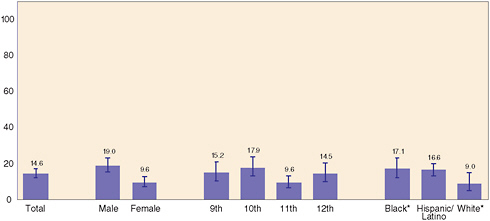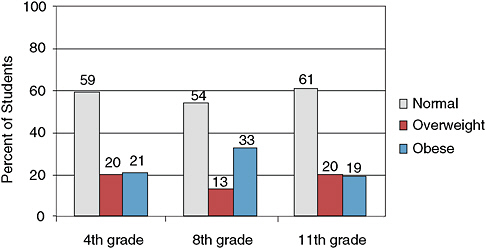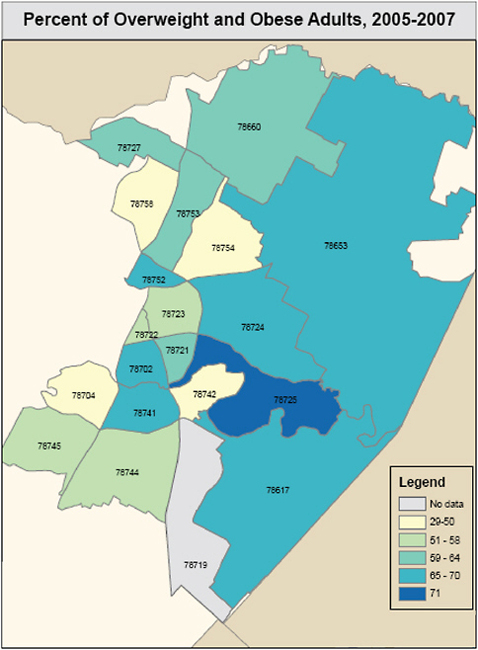6
A Look at the Texas Landscape
Individuals representing four organizations across Texas presented their experiences with childhood obesity prevention efforts in the state. These organizations are currently operating within urban (Austin, Houston), rural (Henderson), and border (El Paso) communities that feature populations of diverse socioeconomic strata and racial/ethnic composition.
CITY OF AUSTIN/TRAVIS COUNTY HEALTH AND HUMAN SERVICES DEPARTMENT
Philip Huang, Medical Director for the Austin/Travis County Health and Human Services Department, described health initiatives carried out in Austin and Travis County. Identification of an obesity problem and health disparities among its population enabled the county to compete successfully for a Steps to a Healthier United States grant from the Centers for Disease Control and Prevention to address obesity, asthma, and diabetes. To put this grant to best use, the region drew on its experience with the Texas Tobacco Prevention Initiative in Travis County, which showed that multi-component interventions involving schools and communities, the media, smoking-cessation programs, and law enforcement were more effective than single-component interventions in reducing tobacco use. Huang commented that successful comprehensive health programs target parents as well as children, since parents are responsible for shaping the home health environment. Although multicomponent interventions require greater investment of resources, these costs are offset by greater benefits in health outcomes. Huang noted, for example, that implementation of the comprehensive Texas
Tobacco Prevention Initiative cost approximately $3 per capita and resulted in a 36 percent reduction in tobacco use among students in grades 6–12 and a 27 percent reduction in tobacco use among adults.
Texas applied these lessons learned in developing Steps to a Healthier Austin, the city’s first large-scale, funded, comprehensive chronic disease prevention program. This program targeted 460,000 high-risk, racially diverse residents within areas of Austin identified as having the highest concentrations of obesity (Figure 6-1). The intervention encompassed 20 contiguous zip code areas comprising 412 square miles, covering primarily east Austin. The racial/ethnic make-up of this area included 41 percent Hispanics, 39 percent non-Hispanic whites, and 14 percent African Americans. Compared with the rest of Travis County, twice as many people in this area were living in poverty, the median income was 60 percent lower, and the unemployment rate was 33 percent higher.
The scope of the childhood obesity problem in the intervention area was measured and established:
-
15 percent of high school students were identified as overweight.
-
85 percent of high school students were not meeting recommended nutrition guidelines by eating five or more servings of fruits and vegetables each day.
-
71 percent of high school students had not been physically active for a total of 60 minutes per day for 5 or more of the past 7 days.
-
69 percent of high school students did not attend a daily physical education class.
Additional statistics on the proportion of overweight students in Austin/Travis County according to different demographic categories are shown in Figure 6-2.
“The objectives for Steps to a Healthier Austin were comprehensive from the start,” said Huang. The program aimed to reduce adult obesity, increase daily consumption of fruits and vegetables, increase child and adult engagement in physical activity, and increase child engagement in school physical education. The program brought together partners from all sectors—schools, communities, health centers, the media, and academia—and engaged them in working toward a common vision. School activities included enhanced physical education curricula, healthy vending machine policies, increased healthy meal choices, school gardens, and safe routes to school. Community activities included summer playground programs; employee wellness programs; improvements to the built environment; healthy cooking programs; and dissemination of information on community resources, such as faith-based organizations, recreation centers, and trails.

FIGURE 6-2 Percentage of Austin/Travis County high school students who were obese (≥ 95th percentile for BMI), as presented by Huang.
NOTE: * = Non-Hispanic.
In addition, federally qualified health centers offered case management and nutrition counseling for obese children, and several surveillance and evaluation tools were implemented to measure change (e.g., Fitnessgram, the Behavioral Risk Factor Surveillance System, the Youth Risk Behavior Surveillance System). Huang indicated that several resources are needed to sustain the Steps to a Healthier Austin program, including continued funding, continued facilitation and coordination of community collaboration, and additional evidence-based practices.
PASO DEL NORTE HEALTH FOUNDATION, EL PASO
The purpose of the Paso del Norte Health Foundation is to promote health and wellness among the 2.2 million people living in El Paso and Hudspeth Counties in west Texas and neighboring regions in southern New Mexico and Chihuahua, Mexico. The foundation carries out its mission through leadership in health education, research, and advocacy.
One of the many initiatives embraced by the foundation is the CATCH initiative (see Box 3-2 in Chapter 3 for an overview of CATCH). The foundation began by implementing the CATCH program in one small school district in El Paso. Through collaboration with teachers and school super-intendants, the reach of the CATCH program grew to include more than 108 schools. Enrique Mata, Senior Program Officer with the foundation, commented that the community became so engaged in the CATCH efforts that a synergy began to develop with other Paso del Norte programs. Imple-
mentation of Walk El Paso increased awareness of the need to change the built environment and address safety issues to help people get out of their homes and participate in physical activity. The Qué Sabrosa Vida program empowered primary meal preparers to present meals to their families using the four Cs: cooking, choosing, controlling, and celebrating.
Mata detailed several strategies that have enabled the Paso del Norte Health Foundation to succeed in improving the health of individuals in the communities it serves:
-
Because the foundation is a regional organization that is relatively isolated geographically, it has become adept at using resources in a creative way.
-
The foundation engages and listens to members of the community to garner their support in a respectful manner.
-
The foundation sets aside money to evaluate the effect of initiatives and document outcomes.
-
Although the foundation focuses on assisting underserved individuals, it does not restrict its efforts to those census tracts most in need; instead, it implements programs across the board to draw on the collective experience of all societal sectors.
-
The foundation looks carefully at all of the support systems in an area to identify appropriate evidence-based interventions that are likely to succeed.
CHILDREN AND NEIGHBORS DEFEAT OBESITY (CAN DO) HOUSTON
Nancy Murray began her presentation on CAN DO Houston by describing the events that led to the formation of the organization. In 2005, Houston was named the fattest city in America. In response, Mayor Bill White started Get Moving Houston, the Mayor’s Wellness Council. In 2006, the Houston Wellness Association was formed; its members include businesses interested in promoting wellness, among others. Shortly thereafter, in 2007, the Center for Clinical and Translational Sciences (CCTS), a collaboration among the University of Texas Health Science Center at Houston, the University of Texas M.D. Anderson Cancer Center, and the Memorial Hermann Healthcare System, was formed through an award from the National Institutes of Health. With this grant, CCTS funded a community engagement corps and a dedicated community engagement specialist.
As community engagement specialist, Nancy Correa listened to the community advisory board and identified childhood obesity as the most pressing issue for community members. She subsequently determined that
there were more than 60 different programs in Houston focused on childhood obesity. Instead of developing another such program, she and her colleagues coordinated these many existing efforts under the CAN DO umbrella to create a community-based initiative aimed at preventing and diminishing childhood obesity through local collaborations. CAN DO listens to the needs of the community and then coordinates and leverages existing resources and services to help communities address their health concerns. The organization has partnered with all the major universities in Houston, the private sector, nonprofit organizations, health care organizations, community programs, and local government to help Houstonians gain access to a healthier lifestyle.
CAN DO initiated a pilot project in August 2008 in two Houston communities. Within each community is a CATCH elementary school and a park that serves as the anchor for physical activities. The first community, Magnolia, is a predominantly low-income Hispanic community, while the second, Sunnyside, is a predominantly low-income African American community. As the point of contact for each of these communities, Correa explained that she quickly became aware of the different needs in each setting.
Most stakeholders in Sunnyside were fairly satisfied with the amount of physical activity in which the community’s children were engaged, but they identified nutrition and parent education as weak areas within a comprehensive healthy lifestyle. In response, CAN DO now offers after-school nutrition lessons for children; wellness education sessions for parents; and grocery store tours for parents and caregivers, focused on how to read nutrition labels.
In comparison with Sunnyside, the Magnolia landscape looked very different. Parents and stakeholders felt that families had access to fruits and vegetables, nutrition education, and a cooking program through another initiative; however, most children were engaging in little physical activity. Recognizing a lack of funding for physical education equipment, CAN DO immediately provided the school with soccer balls for the children. In addition, CAN DO determined that the park located half a mile from the school had free after-school programming, but this programming was not well promoted or incorporated into the community. In a 7-week pilot program, Parks and Recreation staff brought the programming to the elementary school twice a week to encourage the children’s participation. At the end of the pilot, CAN DO promoted a move to the park, emphasizing more days, more resources, and more space. Participation in the after-school program increased following this effort.
LEAN COALITION, HENDERSON
Toinette Ladage prefaced her presentation by explaining that Henderson is a small town of about 12,000 residents in Texas with limited financial resources. Born out of a series of events illuminating the suboptimal health and nutrition of Rusk County residents, particularly schoolchildren (Figure 6-3), the Leadership Encouraging Activity and Nutrition (LEAN) Coalition was formed to lead obesity prevention efforts in the county. As chair of the LEAN Coalition, Ladage stated that its mission is to inform and increase awareness among Rusk County citizens concerning physical activity, nutrition choices, and other behaviors for optimum health.
In response to needs identified through a survey conducted by the City of Henderson Parks and Recreation Department, the LEAN Coalition set its sights on making the entire city a park system by connecting neighborhoods and schools to the parks via sidewalks. Although the coalition secured $1.2 million in grant monies from the Texas Parks and Wildlife Department to improve existing parks and expand recreational facilities within the town, creative tactics devised by LEAN members have greatly advanced the group’s cause while preserving its monetary resources. Mike Barrow, Assistant City Manager, detailed how the coalition managed to acquire a sizable

FIGURE 6-3 Overweight and obesity among schoolchildren in public health region 4-5N (including Rusk County), 2004–2005, as presented by Ladage.
SOURCE: SPAN III Research Project: 2004–2005 results.
parcel of park land through a land swap with a town resident. The coalition also acquired an unused building overseen by the Historical Society that it plans to convert into a senior citizen center, with access to park trails and an indoor swimming pool for all Henderson residents. Using innovation, creativity, perseverance, and commitment, the LEAN Coalition has slowly grown the acreage of Henderson’s system of parks and paved trails.









